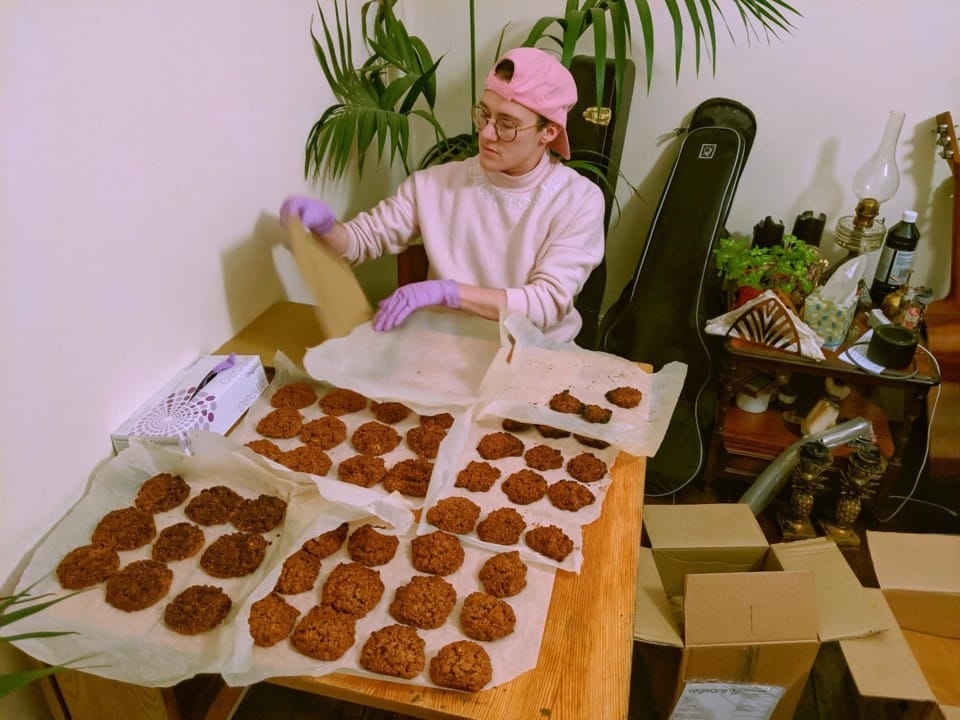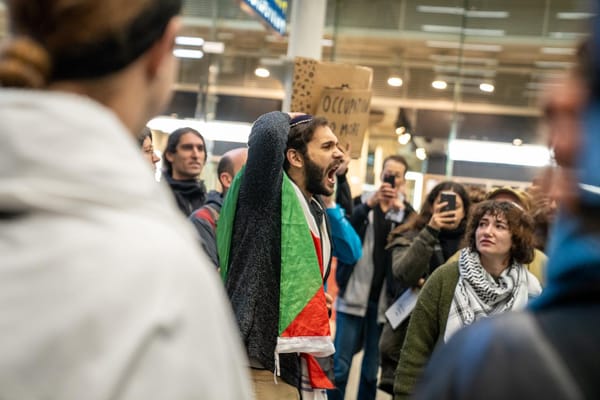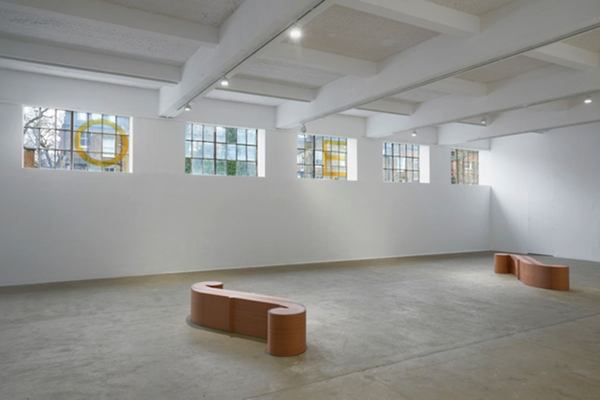Vashti meets Pink Peacock, the world's first queer Yiddish cafe
The founders of the Glasgow establishment, due to open later this year, share their vision of luxury for all.

Pink Peacock, or די ראָזעווע פּאַווע (di rozeve pave), is poised to become the world’s first queer, anarchist, Yiddish vegan cafe. Complete with a free food fridge and bathrooms stocked with tampons, condoms and nappies, its founders Morgan and Joe envisage a space in Govanhill, Glasgow for artists, activists, LGBTQ+ people and wandering Jews of all stripes to schmooze over coffee and rugelach.
Morgan (he/him), a Chicagoan with a background in queer health advocacy, and Joe (he/him), a musician from Yorkshire, met two years ago on Scotland’s queer social scene. Both are active in the Scottish Jewish anarchist collective IRN-JU, which has recently campaigned to save Langside synagogue in Govanhill from redevelopment.
While Yiddish has dwindled outside the Charedi world since the turn of the twentieth century, a generation of non-Charedi Yiddishists is emerging. For them, Yiddish is not just an ancestral language, but a tool of de-assimilation, a link to traditions of Jewish anticapitalism and antifascism. What more Jewish a response to late capitalism than knishes for all?
Last summer, Morgan and Joe devised the idea of a queer Yiddish cafe, and named it: the golden peacock of Yiddish literature was to be reborn in queer clothing. Morgan and Joe quickly attracted attention online. Their crowdfunding campaign launched in July of this year, asking for £10,000 to cover up to three months’ running costs. They received over half of this on the first day, and closed the campaign at the end of August at £15,885.
However, plans for the opening of the bricks-and-mortar cafe were stalled when the pandemic hit. So Morgan and Joe concocted a new plan: if people couldn’t come to the cafe, the cafe would come to them. The pair spent lockdown distributing food packages to Govanhill locals, and organising online events for queer and Jewish communities.
The cafe has begun enacting its founders’ guiding principle: universal luxury. Its food – which will be both halal and kosher certified – is pay-what-you-can, while plans for late-night opening will offer a teetotal alternative to queer nightlife. There will be weekly autism-friendly days and menus in Braille. In contrast to ambient austerity and xenophobia, Pink Peacock promises plenitude to the marginalised.
I met Morgan and Joe on Zoom to discuss their post-Covid plans for opening the cafe, the ideologies that underpin their work, and the process of piecing together a modern, radical Yiddish culture. I’ve edited our conversation for length and clarity.
Why did you start this project?
J: We moved into Govanhill in Glasgow three years ago. Some now-friends of ours were setting up Category Is, the queer bookshop, and that was going brilliantly. It quickly became not just a shop, but a community hub.
M: Before Category Is, Glasgow didn’t have any queer spaces that weren’t clubs or run by charities, and they have been overwhelmed by the community need. The other side of it is the Yiddish and Jewish stuff. There’s nowhere in Glasgow where you can really participate in Jewish life outside of shuls or private houses. I mean there’s Mark’s Deli, but it’s far out of the city. And as for Yiddish stuff, if you thought the queer and Jewish stuff was bad…there is not a single Yiddish institution in Scotland. There is one Yiddish reading group I know about and it’s great, but it’s small, and private. There’s a need as well for free food in our area. Govanhill is particularly vulnerable to food insecurity because people are poor here. A lot of migrants live in Govanhill, a lot of asylum seekers and refugees and broke queers.
J: This area has rapidly gentrified, and we want to combat that.
How would you position Pink Peacock within cultural legacies of Yiddish anarchism, queer liberation and queer Judaism? Do you feel like you’re operating within a tradition, forging a new tradition, or somewhere in between?
M: I feel like we’re absolutely following the Yiddish anarchist tradition, though we also wrestle with it, because the tradition is quite anti-religious. We’re both atheists, but we’re also fairly observant. I don’t think there is another queer Yiddish anarchist vegan pay-what-you-can cafe in the world. That’s new, but it also feels like we’re in conversation with historical movements like Yiddish anarchism, queer liberation. We’re very much in opposition to pinkwashing, queer capitalism bullshit. If it’s not available to poor people, it’s not radical.
With regards to the Jewish stuff, it’s important to us to be accessible to people who might not feel welcome in other Jewish spaces. We have a big focus on de-assimilation. We’re very welcoming to people who don’t have traditional Jewish educations or haven’t been participating in Jewish life, but are interested now. We’re welcoming to patrilineal Jews, to converts, to queer Jews, to leftist Jews who feel locked out by establishment Zionist Jewish institutions.
How do you feel about the Jewish left and your place within it?
M: Right now I feel like this resurgence of the Jewish left is a lot more visible in America, with Jews Against ICE and the anti-occupation work that’s happening. I think it’s interesting that this resurgence is religious. You see a lot of young, lefty Jews wearing prayer shawls on marches, being led by rabbis. I think it speaks to a trend towards de-assimilation among Millennials and Zoomers, a recognition that we don’t benefit from assimilation in the way that our parents and grandparents did.
J: Similarly, there seems to be a resurgence of leftists getting interested in Yiddish.
Learning our ancestral language is an act of de-assimilation and antifascism
Morgan
M: Learning our ancestral language is an act of de-assimilation and antifascism. Learning any language is hard, but Yiddish in particular, because it’s so under-resourced; it’s really difficult to access it if you don’t have the money for classes. We want to make Yiddish as accessible as possible. We also want to make it as queer- and disability-friendly and antiracist as possible, because mainstream Yiddishist culture isn’t. I think it’s less obvious to me that we should try to find our place within Jewish leftism in the UK specifically because we’re anarchists and anti-nationalist. We’re not interested in electoral politics. We’re more interested in directly helping our communities and for us, that means feeding people.
We’re not interested in electoral politics. We’re more interested in directly helping our communities and for us, that means feeding people.
Morgan

For many years it seemed that Yiddish was alive within the Charedi community, but in abeyance within other forms of Judaism. How can Yiddish revivalism reclaim traditions without tokenising them or erasing their histories?
M: Something lots of people say is that Yiddish is being “revived” because it was basically dead before. Obviously it wasn’t. There are more and more native Yiddish speakers every year, because Chasidic communities have loads of kids and teach them Yiddish. I’m not worried about Yiddish dying; it’s thriving.
J: We’ve definitely had to strike a balance between taking ownership over the language and recognising that we are not its sole owners.
M: We’re not native speakers, or fluent by any stretch. We’ve had pushback from some academic Yiddishists who think our Yiddish isn’t good enough to open the cafe. We think that’s crap. As Ashkenazi Jews, we’re entitled to do what we want with Yiddish. Plus Yiddish culture – throughout history, but most recently with the Churban [Holocaust] – has undergone such profound loss that it’s hard for anyone to engage with lots of traditions, because we don’t know what they are. I’ve got a friend, a Yiddish researcher, who learnt recently about this tradition called Feldmesten. You take a ball of wick and you measure the cemetery with it. Then you use that length to make candles. By doing that, you are honouring and in conversation with the dead who are buried there. You can also measure just around the grave of a specific person, to appeal to them to talk to God on your behalf. The way the text talks about the ritual is “You sing this song, then this song, and so on and so on.” There is an assumption that the reader knows the “and so on”. Because we don’t, we have to guess from what fragments are left.
What do you see as Jewish or Ashkenazi food, and how has that informed your menu-planning?
How do you take three ingredients and make them into something beautiful and mass-producible?
Joe
J: Our starting point was “What Ashkenazi Jewish food do we know is good, we can make, is cheap, tasty and luxurious and reproducible on a wider scale?” For our first deliveries in our local area, we did knishes [small pastries filled with various ingredients, often potato or cheese]. I love peasant food. How do you take three ingredients and make them into something beautiful and mass-producible? Jewish food is vast, but it’s often narrowed to this beige platter.
M: Delicious beige platter!
J: Delicious beige platter that we love, but the idea that that’s all there is is unfair. There is a history, similar to Yiddish, that has been lost. Sometimes there are these micro-generational things: for a couple of generations, Jews were suddenly using the herbs and spices that happened to grow in this part of Poland, then that was lost. I’m all about us trying out more colourful and spicier platters.

M: We are a Yiddish cafe and are centring Yiddishkayt, but we don’t want to be limited by that. We’ll be making other stuff like humous, and so much tahini-based food [mimes a chef’s kiss]. It’s funny that Ashkenazi food has become synonymous with Jewish food, because Jewish texts talk about so many different foodstuffs: olives, dates, figs, pomegranates, apples. All of these are part of our ritual.
We’re also interested in the idea of queer food, which is even more nebulous. We did a queer informal discussion group series called Cruisin for a Shmuesn, and the conclusion we all kind of came to there was that queer food is making food available for free, sharing food, doing potlucks, and peasant food.
During the pandemic you pivoted to delivering food packages, a mutual aid food response. How has the current moment influenced your work?
J: Just before Covid, we were planning to start crowdfunding. When the pandemic hit, we didn’t want to ask people for money, because everyone was suddenly jobless. But we had all this infrastructure and awareness, so we pivoted to what we could do: food delivery.
M: The demand always exceeded supply. It’s always been important to us that everything be pay-what-you-can with as much dignity as possible. At the end of the order form it would say: “Based on how much food you asked for, this is the break-even cost,” including our labour and the packaging and all the stuff that goes into it. You have the information to make a choice. If you can’t afford it, that’s fine, don’t give us anything; if you can afford it, please give a bit more.
J: And it works. The thing I was worried about at first was who we were reaching: was the pay-what-you-can model only working because everyone is paying the break-even cost? But then every now and again we’d see that someone had paid two quid for a £12 meal and it was like, “Brilliant, not only are we making our break-even cost, but this framework is allowing people to access food.” You have all of these concerns and fears about what people will and won’t do, but people want the space to exist and are willing to pay for it.
M: Trusting the public makes such a difference. It makes it so much more welcoming, especially for marginalised people who are used to being considered suspicious. There was one time it seemed like we were going to be a little bit under budget, and we posted about it online and instantly got ten donations to make up for it. Some of our donations came from the US or Canada, which means we’re inviting international solidarity and that’s fabulous.

You’ve spoken about how gatekeeping and inaccessibility affect even supposedly radical spaces. How did you seek to make Pink Peacock accessible?
J: We were tired of politically compromising spaces that were like, “We’re really good at this one thing, but we work with cops.” Then it came to us: we can make a space without that “but”.
We were tired of politically compromising spaces that were like, “We’re really good at this one thing, but we work with cops”. Then it came to us: we can make a space without that “but”.
Joe
M: It comes from not only our experience of being disappointed with so-called radical or queer-friendly spaces. We’ve both, in different ways, got experience of working with or being part of vulnerable communities, and knowing how shit most organisations are about it. I used to be a sex worker, I’m non-binary, we’re both autistic and neither of us had a Jewish education, so we both have weird Jewish authenticity feelings. I used to be an undocumented migrant. [To Joe] Your mom’s work about disability [as a care worker and in special needs education] has really informed what we do. Witnessing shitty conversations about race and antisemitism has shown us how important it is for us as white Jews to be actively antiracist. Age is also quite important to us. Queer spaces tend to cater for 18-35-year-olds, but if you have a family, or you’re underage, or you’re older… And of course, there are the identities that we don’t have, but we recognise that their struggles are also our struggles. There’s no liberation for us if not for them as well.
J: That’s not to say we have perfect views. We want to make sure we are beholden to our communities, that there are quick and easy channels to tell us where we’ve done something wrong or made a mistake.
M: So until recently, our logo was a triangle with a pink outline and black interior. The pink triangle has been a queer rights symbol for a long time. We didn’t know that the black triangle was a symbol of Romani loss during the Porajmos [the Romani word for the Holocaust]. On Romani Holocaust Remembrance Day, we had a couple of people message us. People were upset but overwhelmingly kind, which they didn’t owe us. We try to receive any call-out or call-in in good faith. We changed the logo that day and apologised.
J: There’s this idea that saying “we are X-inclusive” is enough. It isn’t. It’s an ongoing process of working with people.

Were your anti-Zionist commitments informed by Jewish traditions like Bundism, or do they stem more from anarchist views of the state?
M: Our anti-Zionist ideology comes from being anarchists. The State of Israel is 70 years old now, and hasn’t served us; the Yiddish anarchists were right.
J: There is an accessibility issue, too. If we call ourselves a Yiddish space without doing something to welcome Palestinians or people who would otherwise be uncomfortable around Zionists, there would be a barrier for them.
M: As Jews, we are committed to justice, and that means justice for Palestine. It also feels important to show not just solidarity, but a Jewish tradition of anti-Zionism. I feel so insulted by the Israeli propaganda that says “all Jews are Zionists”. You can’t say “all Jews” anything; you can say “all Jews are Jewish”, and that’s about it.
What’s your vision for the future of the cafe?
J: At a bare minimum, that it will be providing accessible food to people.
M: We hope that the cafe is a community organising space. That might mean a tenants’ union has a meeting in our cafe, or a Gaelic language group holds workshops here. We already host weekly online havdalahs [ceremonies marking the end of Shabbat], and Cruisin for a Shmuesn was really successful. We just want to keep doing those things, building on them and responding to what the community asks for. Ideally, the cafe will be open 24 hours, or for as much time as Glasgow Council will allow, as a sober space for people to loiter in. That would mean bringing on more workers. As anarchists we believe in non-hierarchical organising: everyone who works at the cafe will be on our board of directors, and we’ll all have equal pay.
J: I would consider this space a success if people are hanging out and not buying things. If it’s a place that doesn’t have capitalistic incentives or a high turnover rate with hard, uncomfortable surfaces encouraging you to buy a coffee and bugger off. I would consider it a success if there are intergenerational customers. That’s just so missing from queer and Jewish stuff. We had a really nice conversation in one of the other Cruisin for a Shmuesns about queer ageing bodies. It was just so lovely to hear from older queers and older Jews.
I would consider this space a success if people are hanging out and not buying things. If it’s a place that doesn’t have capitalistic incentives or a high turnover rate with hard, uncomfortable surfaces encouraging you to buy a coffee and bugger off.
Joe
M: I think our ambition is to balance love and rage. We want to welcome and witness people’s anger, because it’s valuable and powerful and justified, but we also want it to be helpful and cathartic, to drive action.

Anya Metzer is an editor at Vashti. She studied gender, pathology and Victorian social thought in English literature, and works in international development.




